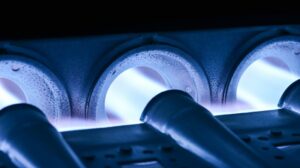
If you’re like many homeowners in the Dunwoody area, you likely have a gas-powered furnace in your home to keep yourself and your family warm. Furnaces are a great heating choice, as they are powerful and very cost-effective.
Today’s furnaces even have a higher efficiency rating than just a short decade ago. In fact, the highest AFUE (annual fuel utilization efficiency) rating for a gas furnace is 98%. Trust us, that’s efficient!
In addition to high efficiency, you want to know you can rely on safety when it comes to your heating system, right? Gas furnaces certainly are not dangerous by nature. However, if you don’t take care of your furnace as you should, then it can certainly become dangerous.
The most common culprit of a dangerous furnace, especially an older one, is a cracked heat exchanger. For a deeper understanding of why this issue is so critical, check out furnace repair needs and the danger of a cracked heat exchanger. Even if you don’t have an obvious problem with your furnace’s heat exchanger right now, if your system is 15+ years old, it’s time to start considering an upgrade.
Read on to learn more!
What Is a Heat Exchanger?
We’re here to answer just that! This component isn’t just important for the operation of your gas-powered furnace, it’s completely necessary. The heat exchanger is where the heat from combustion gases collects to heat up the metal walls of the heat exchanger. Then the air passes over it and brings heat into your living space.
In other words, the heat exchanger is actually the part of your heating system responsible for safely bringing the heat it.
How it works is that combustion gases enter the clamshell-shaped chamber of the heat exchanger. The gas raises the temperature of the metal walls, as we mentioned above, and then the blower fan of the furnace pushes air over the metal chambers. The heat exchanger serves as a barrier between the combustion gas and the air that goes into your home.
The Harm of a Cracked Heat Exchanger
Over time, natural wear and tear impact your furnace, including the heat exchanger components. Every time your furnace’s heat exchangers warm up, the metal walls expand. Then they contract as the furnace cools down. After years and years of this process, the heat exchangers are prone to corrosion and subsequent damage. To find out how long you might expect your furnace to last and when replacement is necessary, visit how long you can expect your furnace to last.
These cracks are very small. In fact, they’d be invisible to the average homeowners. However, when the heat exchangers get hot again and therefore expand, it causes the cracks to open up, which is when combustion gases can leak out. When a furnace is ventilated as it should be, this might not be a problem–carbon monoxide may get safely filtered into the outdoor air.
But the problem is that many times, with older furnaces, the carbon monoxide makes its way into the home, and can lead to harmful carbon monoxide poisoning. This leads to hundreds of illnesses and even fatalities every year.
The best way to avoid this problem is to ensure that you stay on top of your annual furnace maintenance appointments. If you haven’t scheduled a furnace tune-up in the last year, now is the perfect time to give us a call! Regular maintenance can help you determine if it’s time to replace your heater and guide you toward the best system for your needs.
For professional service on your heating in Dunwoody, GA, look no further than DC Cheek Heating, Cooling & Plumbing. Contact us today!



